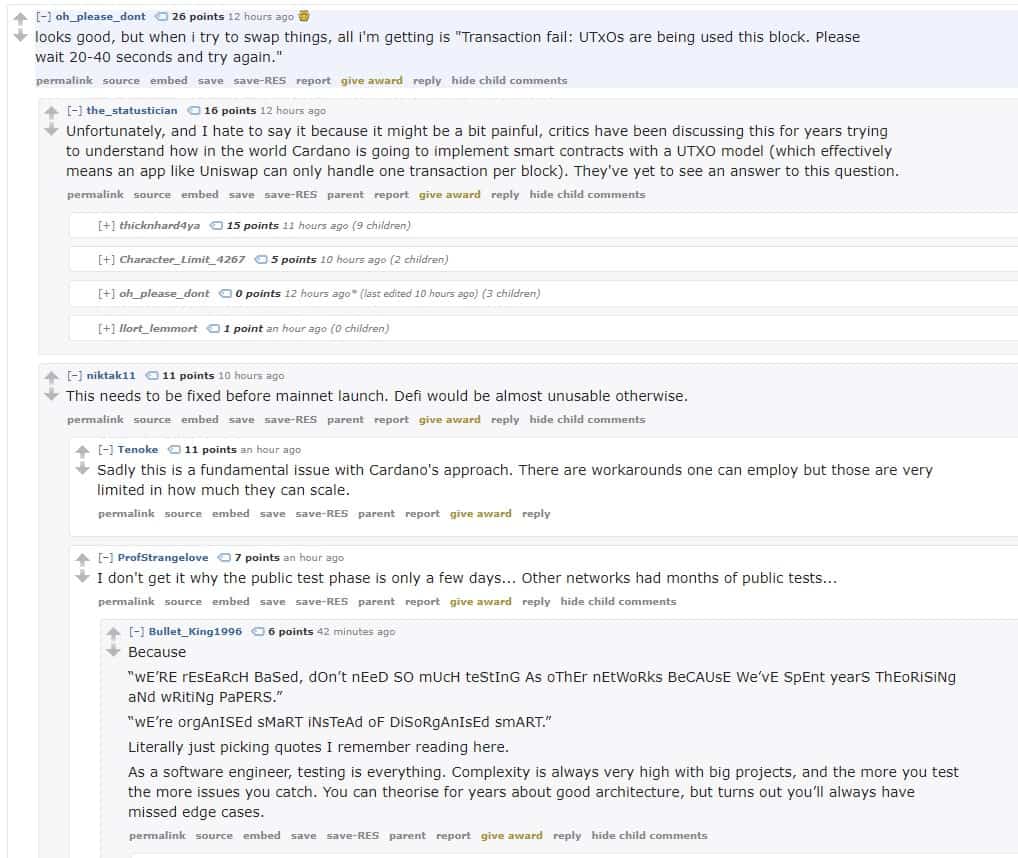Cardano, the third-largest cryptocurrency by market capitalization, has been gathering momentum in anticipation of its smart contracts mainnet upgrade.
The Cardano team announced in September 2021 that the smart contract functionality was made available on its Alonzo testnet, while its mainnet is expected to be deployed by September 12.. However, the feature has been under criticism by some in the cryptocurrency industry due to a concurrency issue.
But there are some, like Ethereum proponent Anthony Sassano, who outlined a supposed fundamental issue related to concurrency on Minswap – Cardano-based decentralized exchange (DEX).
What is a concurrency issue – you may ask? Basically, it prevents multiple users from interacting with a program or protocol simultaneously.
In the case of Cardano, there were some users concerned about the inefficiency of Minswap, as it only handled one transaction per block. However, the network’s founder I response, Charles Hoskinson explained the intricacies of Cardano’s structure and the upcoming smart contracts, as well as how it differs from existing networks.
Addressing the Validation Issue
The Cardano team published on September 5 an explanation about the non-surprise transaction validation process on Alonzo and highlighted the following about the minting process through the Plutus script:
“An important aspect of processing a transaction is validating the actions it is taking. A transaction is taking an action when it contains data in the specific field to that action. For example, a transaction is spending UTXO U when it contains a reference to U in its input field, and it is minting a token X when its mint field contains X.2.”

The strain of concurrency issues forced Minswap to shut down its testnet. However, the DEX already notified publicly about the matter via Twitter, saying that if a user sees an error message which states that UTXOs are being used this block’ too many times, it’s because the concurrency problem is happening and they’re attempting to fix it.
There are voices in favor of Minswap, such as Maladex, another DEX building on Cardano, highlighting that it’s a ‘very challenging issue to solve’ and should be understandable from the point of view that it’s an unfinished product at this stage.
Two Phases for Transaction Validation
From a technical point of view, the Cardano team explained in a long-form blog post that transaction validation is divided into two phases. The reason? It should limit the amount of uncompensated validation work by nodes:
“Each phase serves a purpose in achieving this goal. Roughly speaking, the first phase checks whether the transaction is constructed correctly and can pay its processing fee. The second phase runs the scripts included in the transaction. If the transaction is phase-1 valid, phase-2 scripts run. If phase-1 fails, no scripts run, and the transaction is immediately discarded.”
Furthermore, the Cardano team argued that Alonzo introduced a special provision to compensate the nodes for their work if scripts are not validated. That’s why they would rely on introducing the collateral in transactions, which basically is the amount of ADA that will be collected in the form of a fee if a phase-2- script validation fails.
Smart Contract Update Still Scheduled as Expected
As per the release of the smart contract update, the deadline for which is approaching, as IOHK confirmed that it would happen on September 12 at 21:44:51 GMT. Also, 80% of the pools are expected to be ready for the Alonzo update at that date.
According to the team, its core Plutus capability will be deployed on the mainnet through HFC on that same date, together with compatibility upgrades throughout the entire software stack.
There are no expectations to delay further the deployment of the update to trigger the hard fork, although it’s still subject to any additional issues that could happen in the meantime.
Also, more Cardano-based DEXs such as SundaeSwap Labs are expecting to see the mainnet working in its fullness to address several issues despite the criticism arisen over the last few weeks. In fact, the DEX pointed out that Cardano has not dug its own grave as many have claimed:
“So to the people claiming this is the death of Cardano: unlikely. To point to one rocky experiment in the earliest of early days of an ecosystem and hold it up as the fatal omen of Cardano’s downfall is premature naïveté at best and intellectual dishonesty at worst.”
Cardano vs. Ethereum Battle Could Strengthen
That said, the crypto community keeps expecting to see how the so-called Cardano vs. Ethereum develops after the update, where dApps could be a reality on the Cardano’s blockchain.
In the meantime, on September 7, IOHK confirmed that it submitted an update’s proposal to the Cardano mainnet, even claiming that the Alonzo HFC event will be ‘the most significant upgrade yet’ and thus the beginning of a new era of smart contracts in Cardano.


















